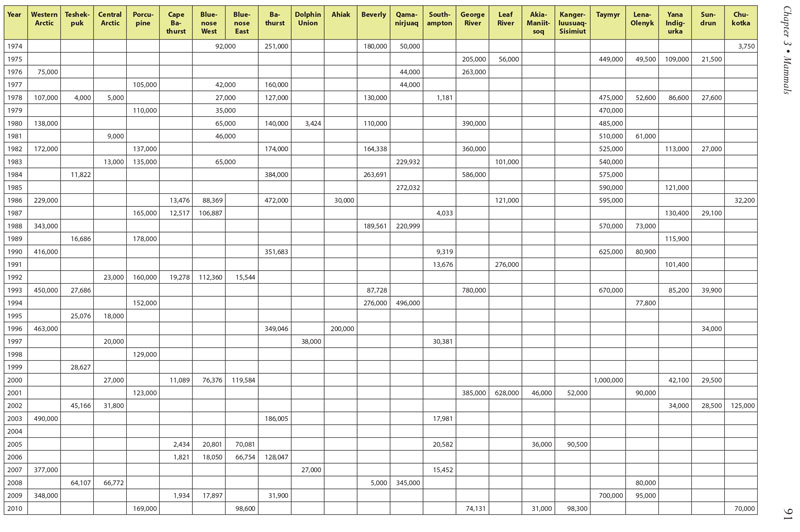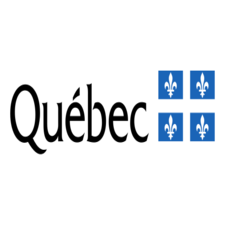caribou
Type of resources
Available actions
Topics
Keywords
Contact for the resource
Provided by
Formats
Representation types
Update frequencies
status
-

Distribution and observed trends of wild Rangifer populations throughout the circumpolar Arctic (from The Circum Arctic Rangifer Monitoring and Assessment Network, CARMA). Note: Wild boreal forest reindeer have not been mapped by CARMA and thus are not represented here. Published in the Arctic Biodiversity Trends 2010 - Selected indicators of change, INDICATOR #02 - released in 2010
-

Broad management guidance is applied across each Cervid Ecological Zone (CEZ) to help set local population and habitat objectives. CEZs reflect the overarching cervid management intent at the landscape level. The foundation for CEZs is Ontario’s Ecological Land Classification, with consideration given to: * cervid species ranges * landscape level variations in habitat and climate CEZs build on the existing Wildlife Management Unit network while recognizing that species and habitat ranges fluctuate over time.
-

Summer/Fall and Winter/Forest-Dwelling 2017 habitat model for caribou in the Itcha Ilgachuz area. [Season] field should be used to split the data out into separate summer/fall and winter/forest-dwelling habitat models. Model development is detailed in _Apps, C., and N. Dodd. 2016.. Caribou habitat modeling and evaluation of forest disturbance influences across landscape scales in west-central British Columbia – March, 2016. Prepared for Ministry of Forests, Lands and Natural Resource Operations, Williams Lake, British Columbia_. See also: https://catalogue.data.gov.bc.ca/dataset/7ea6556b-c113-4194-92f2-7ddb55a340b6 __Note: The 2001 habitat model covers a similar area, but is not replaced by the 2017 habitat model.__
-

Table 3.1. Summary of historical population estimates for 22 circumpolar caribou and wild reindeer herds. Data courtesy of Circum-Arctic Rangifer Monitoring Assessment Network (CARMA) and D.E. Russell & A. Gunn; www.carmanetwork.com/display/ public/home. Data vary substantially among herds and over time in accuracy and precision, and represent only general patterns of abundance. Conservation of Arctic Flora and Fauna, CAFF 2013 - Akureyri . Arctic Biodiversity Assessment. Status and Trends in Arctic biodiversity. - Mammals(Chapter 3) page 91
-

The purpose of this dataset is to give an accurate representation of the game hunting boundaries in Manitoba. The purpose of this dataset is to give an accurate representation of the game hunting boundaries in Manitoba.Game Hunting Areas (GHAs) are defined under the Hunting Areas and Zones Regulation (220/86) of The Wildlife Act (CCSM c. W130). Game Hunting Areas are used to support boundaries for species-specific hunting seasons, harvest allocations, bag limits and associated regulations. Refer to the Hunting Areas and Zones Regulation for GHA boundary descriptions.Fields included (Alias (Field Name): Field description)OBJECTID (OBJECTID): sequential unique whole numbers that are automatically generated GHA (GHA): the number assigned to each Game Hunting Area Shape_Length (Shape_Length): the length of the feature in internal units Shape_Area (Shape_Area): area of the feature in internal units squared
-

The Broad Ecosystem Inventory (BEI) Classification provides broad regional information about the distribution of ecosystems throughout the province and the value of these ecosystems to wildlife. This work is done in order to facilitate the use of wildlife information in broad provincial and regional land and resource planning initiatives. Broad Ecosystem Units are mapped based on imagery of the provincial land base generally captured at a scale of 1:250,000. BEI mapping represents forest conditions from approximately 1995 to 2000. The BEI Classification was used to produce wildlife habitat capability and suitability mapping following Provincial Wildlife Habitat Ratings (WHR) Standards (Resource Inventory Committee 1999). Habitat classifications were based on BEI units. BEI units were evaluated and rated to determine the habitat potential (capability) and current habitat conditions (suitability) for selected wild ungulates and furbearers within each seral stage within each Broad Ecosystem Unit (and related site modifier variation) within the framework of Ecosections and Biogeoclimatic Sub-zone/Variants for their ability to supply the species’ necessary life requisites. Regional Wildlife and Habitat biologists, technicians, Forest Ecosystem Specialists, and consulting species experts provided species habitat ratings for each region of the province. Wildlife habitat capability and suitability mapping was completed for the following wild ungulates and furbearers: Northwestern Moose, Alaskan Moose, Shiras' Moose, Bison, Rocky Mountain Elk, Roosevelt Elk, Columbian Black-tailed Deer, Rocky Mountain Mule Deer, Sitka Black-tailed Deer, White-tailed Deer, Dakota White-tailed Deer, Northwestern White-tailed Deer, Boreal Woodland Caribou, Mountain Woodland Caribou, Northern Woodland Caribou, Lynx, Bobcat, and American Badger. Habitat mapping followed Provincial Wildlife Habitat Ratings (WHR) Standards (Resource Inventory Committee 1999).
-

To help wildlife managers obtain information about CWD prevalence in the province, hunters are asked to drop off heads from deer, elk, moose, and caribou for CWD testing at the following locations (see map below). PLEASE NOTE: Each self-serve drop-off site contains a kiosk and a chest freezer. Freezer space at high-traffic drop-off locations may be limited early in the hunting season when temperatures are not consistently below -10C and therefore do not allow for heads to be submitted within the kiosk. Prior to dropping off large elk and moose heads at these busy sites, please call ahead to the phone number associated with each kiosk to ensure there is adequate freezer space to allow for drop-off.
-

The purpose of this dataset is to give an accurate representation of the game hunting boundaries in Manitoba. The purpose of this dataset is to give an accurate representation of the game hunting boundaries in Manitoba.Game Hunting Areas (GHAs) are defined under the Hunting Areas and Zones Regulation (220/86) of The Wildlife Act (CCSM c. W130). Game Hunting Areas are used to support boundaries for species-specific hunting seasons, harvest allocations, bag limits and associated regulations. Refer to the Hunting Areas and Zones Regulation for GHA boundary descriptions.Fields included (Alias (Field Name): Field description)OBJECTID (OBJECTID): sequential unique whole numbers that are automatically generated GHA (GHA): the number assigned to each Game Hunting Area Shape_Length (Shape_Length): the length of the feature in internal units Shape_Area (Shape_Area): area of the feature in internal units squared
-

The purpose of this dataset is to give an accurate representation of the game hunting boundaries in Manitoba. The purpose of this dataset is to give an accurate representation of the game hunting boundaries in Manitoba.Game Hunting Areas (GHAs) are defined under the Hunting Areas and Zones Regulation (220/86) of The Wildlife Act (CCSM c. W130). Game Hunting Areas are used to support boundaries for species-specific hunting seasons, harvest allocations, bag limits and associated regulations. Refer to the Hunting Areas and Zones Regulation for GHA boundary descriptions.Fields included (Alias (Field Name): Field description)OBJECTID (OBJECTID): sequential unique whole numbers that are automatically generated GHA (GHA): the number assigned to each Game Hunting Area Shape_Length (Shape_Length): the length of the feature in internal units Shape_Area (Shape_Area): area of the feature in internal units squared
-

Wildlife Habitats (HAFA) contains data for the 11 legal wildlife habitats located on land under the domain of the State and is protected under the Wildlife Habitat Regulations (RHF). There are also HAFAs located on mixed and private lands for information purposes. Since they are essential environments for wildlife, the eleven habitats benefit from legal protection in Quebec. __The conservation of wildlife species and their habitats is beneficial for biodiversity. Each of these species plays an important role in our ecosystems. __ ### #Mise on guard: The digital version of geo-descriptive data describing wildlife habitats is produced from a legal perspective of location, protection and management of habitats. In fact, only the digital version that has been published in the Official Gazette of Quebec is recognized as legal. Last publication of wildlife habitats: November 17, 2022.**This third party metadata element was translated using an automated translation tool (Amazon Translate).**
 Arctic SDI catalogue
Arctic SDI catalogue